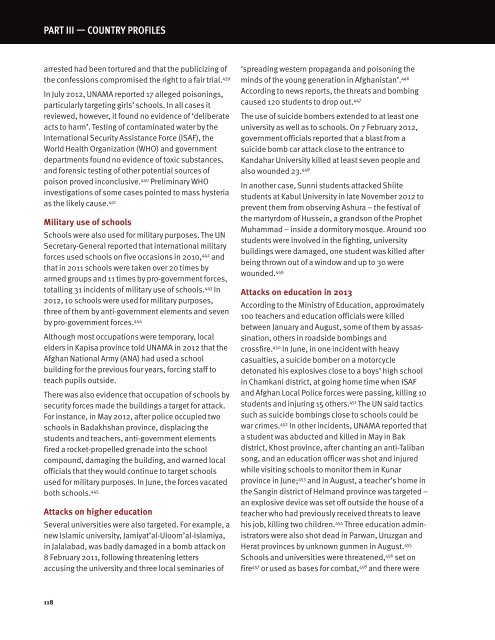Create successful ePaper yourself
Turn your PDF publications into a flip-book with our unique Google optimized e-Paper software.
PART III — COUNTRY PROFILeS<br />
arrested had been tortured and that the publicizing of<br />
the confessions compromised the right to a fair trial. 439<br />
In July 2012, UNAMA reported 17 alleged poisonings,<br />
particularly targeting girls’ schools. In all cases it<br />
reviewed, however, it found no evidence of ‘deliberate<br />
acts to harm’. Testing of contaminated water by the<br />
International Security Assistance Force (ISAF), the<br />
World Health Organization (WHO) and government<br />
departments found no evidence of toxic substances,<br />
and forensic testing of other potential sources of<br />
poison proved inconclusive. 440 Preliminary WHO<br />
investigations of some cases pointed to mass hysteria<br />
as the likely cause. 441<br />
Military use of schools<br />
Schools were also used for military purposes. The UN<br />
Secretary-General reported that international military<br />
forces used schools on five occasions in 2010, 442 and<br />
that in 2011 schools were taken over 20 times by<br />
armed groups and 11 times by pro-government forces,<br />
totalling 31 incidents of military use of schools. 443 In<br />
2012, 10 schools were used for military purposes,<br />
three of them by anti-government elements and seven<br />
by pro-government forces. 444<br />
Although most occupations were temporary, local<br />
elders in Kapisa province told UNAMA in 2012 that the<br />
Afghan National Army (ANA) had used a school<br />
building for the previous four years, forcing staff to<br />
teach pupils outside.<br />
There was also evidence that occupation of schools by<br />
security forces made the buildings a target for attack.<br />
For instance, in May 2012, after police occupied two<br />
schools in Badakhshan province, displacing the<br />
students and teachers, anti-government elements<br />
fired a rocket-propelled grenade into the school<br />
compound, damaging the building, and warned local<br />
officials that they would continue to target schools<br />
used for military purposes. In June, the forces vacated<br />
both schools. 445<br />
Attacks on higher education<br />
Several universities were also targeted. For example, a<br />
new Islamic university, Jamiyat’al-Uloom’al-Islamiya,<br />
in Jalalabad, was badly damaged in a bomb attack on<br />
8 February 2011, following threatening letters<br />
accusing the university and three local seminaries of<br />
‘spreading western propaganda and poisoning the<br />
minds of the young generation in Afghanistan’. 446<br />
According to news reports, the threats and bombing<br />
caused 120 students to drop out. 447<br />
The use of suicide bombers extended to at least one<br />
university as well as to schools. On 7 February 2012,<br />
government officials reported that a blast from a<br />
suicide bomb car attack close to the entrance to<br />
Kandahar University killed at least seven people and<br />
also wounded 23. 448<br />
In another case, Sunni students attacked Shiite<br />
students at Kabul University in late November 2012 to<br />
prevent them from observing Ashura – the festival of<br />
the martyrdom of Hussein, a grandson of the Prophet<br />
Muhammad – inside a dormitory mosque. Around 100<br />
students were involved in the fighting, university<br />
buildings were damaged, one student was killed after<br />
being thrown out of a window and up to 30 were<br />
wounded. 449<br />
Attacks on education in 2013<br />
According to the Ministry of Education, approximately<br />
100 teachers and education officials were killed<br />
between January and August, some of them by assassination,<br />
others in roadside bombings and<br />
crossfire. 450 In June, in one incident with heavy<br />
casualties, a suicide bomber on a motorcycle<br />
detonated his explosives close to a boys’ high school<br />
in Chamkani district, at going home time when ISAF<br />
and Afghan Local Police forces were passing, killing 10<br />
students and injuring 15 others. 451 The UN said tactics<br />
such as suicide bombings close to schools could be<br />
war crimes. 452 In other incidents, UNAMA reported that<br />
a student was abducted and killed in May in Bak<br />
district, Khost province, after chanting an anti-Taliban<br />
song, and an education officer was shot and injured<br />
while visiting schools to monitor them in Kunar<br />
province in June; 453 and in August, a teacher’s home in<br />
the Sangin district of Helmand province was targeted –<br />
an explosive device was set off outside the house of a<br />
teacher who had previously received threats to leave<br />
his job, killing two children. 454 Three education administrators<br />
were also shot dead in Parwan, Uruzgan and<br />
Herat provinces by unknown gunmen in August. 455<br />
Schools and universities were threatened, 456 set on<br />
fire 457 or used as bases for combat, 458 and there were<br />
118


